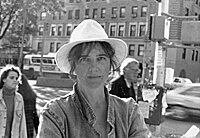Chinook man in canoe, circa 1910, by Edward Curtis
Another lost film I hope I get to see!
Ron Finne’s Tamanawis Illahee is a perfect demonstration of Oregon’s deep, and deeply unacknowledged, biculturality. Here’s the synopsis from the Canyon Cinema catalog:
Tamanawis Illahee (Medicine Land) (1983) 58 min 16mm
A film of the Pacific Northwest, the native people, poetry, history and the forces of change.“TAMANAWIS ILLAHEE, subtitled RITUALS AND ACTS IN A LANDSCAPE, is an homage to the Indian heritage of the Pacific Northwest and a study in the contrast of how native people used the land, as opposed to European settlers who gradually took it over. “It is experimental in style, combining time-lapse photography, archive footage, classic photographs by documentarist Edward Curtis, museum artifacts and other image sources.
“The film is a plea for a spiritual reconnection with native forebears
and a recognition of their heritage.” – Ted Mahar, The OregonianThis film was made possible in part by a grant from the Oregon Committee for the Humanities, an affiliate of the National Endowment for the Humanities.
I understand George Venn’s poem, Directions For Visitors, is featured in Tamanawis Illahee.
DIRECTIONS FOR VISITORS
by George Venn
If you want to find my place
get out of town any way you can.
Find the Cascades in early morning.
When you see the Tatoosh Peaks
where the Nisqually flows
into Alder Lake at Elbe, stop,
ask directions at the grocery.
I won’t be mourning in the tavern.
The Post Office closed last year.
I have no phone and mail hardly comes.
Take the road to Alder by the lake.
When you see the garden above the road
that will be Uncle Ernest’s homestead.
He’s 95 this year, prays every day.
Keep going. When you reach the crest
you will see Uncle Leonard’s pasture
on the left, Grandpa Mayo’s honey house
across the road. Grandma still lives
that farm alone. Cross the swamp
on Alder Creek past Uncle Charlie’s pond.
My father’s house is on the left knoll.
He died and I moved away to town.
On the next wide curve, turn right
onto the gravel going uphill until
you come to a Dead End sign hidden
in the grass and fireweed. Turn there.
To the right. This will be two ruts
a berm of grass down the center
mudpuddles and chuckholes all along.
In one place, a creek flows across.
No more signs now. Curves will be blind.
I’d suggest slowing down.
In two miles, you’ll come to a gate.
Park there and get out. You will hear
Clear Creek splashing over stones,
a dipper will welcome you upstream.
Follow the current through bracken
buttercups, devil club, blackberries
skunk cabbage, deadfall cedar and alder
until you come to a waterfall and pool
surrounded by second growth fir.
I should be there fishing somewhere.
You may see the smoke from my fire
rising like a ghost through green limbs.
If you don’t see me, don’t call.
This place can’t hear a shouting voice.
I’ll know you have come by the way
the crows and chickadees carry on.
I’ll come out then and eat lunch
with you and we can talk and feed sticks
to the fire. If you wait an hour or more
and I don’t appear somehow,
I’m simply not the George you knew.
Catch a few fish for yourself then–
under the falls is the best cast.
If my fire’s out, there’s still wood.
Make a fire of your own, eat, get warm,
and leave the same way you came by dark.
Please do not tell anyone where I live.
Try to forget this place all the way home.
Director Ron Finne is appearing at the April 2 screening of his 1972 film, Natural Timber Country, at the Whitsell.
I hereby claim Tamanawis Illahee, sight unseen, as an Oregon film, based on the Oregon citizenship of director Ron Finne.



0 responses so far ↓
There are no comments yet...Kick things off by filling out the form below.
Leave a Comment